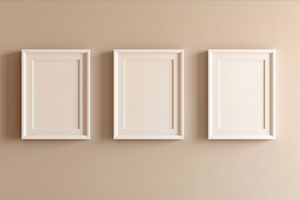
A recent article in The Guardian describes an “exhibition” by the Danish “artist” Jens Haaning. The show at the Kunsten Museum in Aalborg, Denmark, consists of two blank canvases titled “Take the Money and Run.” To prepare the exhibition, the museum loaned Mr. Haaning 532,000 krone (about $75,000). The museum also paid an “artist’s fee” of 40,000 kroner (about $5,600).
Modern Art or Old-Fashioned Fraud?
When the frames were delivered to the museum, the staff actually put the “artwork” on the walls. Only later did those in charge decide to take Mr. Hanning to court, deciding that he indeed took the money and ran. The court decided that the museum should get its loan back, but the artist got to keep the fee.
Haaning also managed to give a Marxist spin to the fraud by claiming “Take the Money and Run” “questions artists’ rights and their working conditions in order to establish more equitable norms within the art industry.” The work represented a working man’s revolt against the establishment.
So, the question stands: did Mr. Hanning see his empty frames as meaningful, or was he using them to defraud the museum by getting paid for work he never did? This question has profound implications.
Not everyone can walk into a museum and raid their bank account. Mr. Hanning’s reputation is such that the Göteborg International Biennial for Contemporary Art described him in 2017 as “one of the most significant and critically-engaged artists of his generation. Haaning has produced a body of conceptual artworks since the 1990s, which, when seen together, offers an acute reflection of a complex and changing society in the West. They are works that necessitate a debate around secularization, including the related subjects of migration, displacement, gender equality, nationalism and freedom of expression.”
Defining the (Deliberately) Obscure
For those who respect traditional ideas about truth, goodness and beauty, ponderous rhetoric such as that used by the Göteborg rankles. Few attitudes are as irritating as those of “modern artists” and their followers. The words and the attitudes behind them attempt to convey a wisdom the speakers do not possess. Modern art is a language unto itself, designed to separate the enlightened from the simple folk who refuse to adopt their pseudo-sophisticate posture. For this article, the terms “modern art” and “abstract art” are treated as synonymous.
Help Remove Jesus Bath Mat on Amazon
In his book Visual Thinking, Rudolph Arnheim defined abstract art as a “visual language” that uses shape, form, color and line to create images that “exist with a degree of independence from visual references in the world.” In other words, the artist isn’t trying to depict anything that actually exists—or ever existed.
Although some art historians consider such nineteenth-century schools of art as romanticism and impressionism as precursors, abstract art is a primarily twentieth-century movement that continues today.
What Does it Mean?
The issues that surround the meaning of a piece of art raise two major questions. First, should an image be so obscure that two equally intelligent and informed people can disagree about its message? Second, can any image without a clear message be classified as beautiful?
When viewing modern art, one viewer often sees meanings that escape another. Such errors fit nicely into a narrative that abhors any sense of objective truth. You see it your way, and I see it mine. Who is to say if either of us sees the painting accurately? Your “truth” is as good as mine.
Satanic Christ Porn-blasphemy at Walmart — Sign Petition
Such a proposition is inherently opposed to the Christian view of the world. The Catholic Encyclopedia defines truth beautifully. “Every existing thing is true, in that it is the expression of an idea which exists in the mind of God, and is, as it were, the exemplar according to which the thing has been created or fashioned.” The Encyclopedia then draws a connection between God and the artist. “Just as human creations—a cathedral, a painting, or an epic—conform to and embody the ideas of architect, artist, or poet, so, only in a more perfect way, God’s creatures conform to and embody the ideas of Him who gives them being.”
Can Modern Art Be Beautiful?
However, abstract art’s message is, by definition, unclear. As such, it can serve no purpose since there is no clear truth or idea to which it points.
Could such a piece of art be beautiful, even if its meaning is uncertain? That question brings us into the realm of aesthetics. In the modern world, aesthetics are erroneously considered merely personal tastes, as in the oft-quoted phrase, “Beauty is in the eye of the beholder.”
How Panera’s Socialist Bread Ruined Company
This phrase has become rooted in the modern mind so profoundly that it is accepted as true by the general population, including, unfortunately, many Christians. The sentiment behind the phrase is, however, one of those lies that never becomes true despite its popularity or the number of times it is repeated. Its origin is an 1878 novel. It rephrases a sentence from the Scots philosopher during the so-called Enlightenment, David Hume, “Beauty in things exists merely in the mind which contemplates them.”
The Search for Genuine Beauty
The foundation of true esthetics and actual beauty does not depend on anything so fleeting and unreliable as human opinion. According to the Catholic Encyclopedia, these are an ideal that “loves great subjects, a lofty conception, monumental execution; it looks to find the divine and the spiritual in all things.” (Emphasis added.)
In essence, the search for beauty is one component of the search for God. The more like God an object is, the more beautiful it becomes. Therefore, the often deliberate ugliness of abstract art is a rejection of God Himself.
The modern world delights in shaking any belief in God. It is a world of blank canvases.
Photo Credit: © seogi – stock.adobe.com


